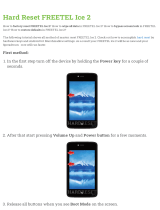
Switching the power off
1. If the display is off, press the POWER button to turn it back on.
2. Press and hold the POWER button for a few seconds.
3. Tap Power off on the options menu.
Setting up HTC 10 for the first time
When you switch on HTC 10 for the first time—or after you've done a factory reset—you’ll need to
set it up.
If you have data from a previous HTC phone that you need to copy, first back up the phone's data
before you start setting up HTC 10. For guidance, go to htc.com/support and then click Backup
and Transfer.
1.
If you need to navigate by voice feedback, turn on TalkBack by pressing and holding two
fingers on the first screen until you hear a message and then a beep.
Or if you accidentally enabled TalkBack, follow the onscreen tutorial to turn it off.
2. Choose the system language you want to use, read and agree to the terms of use, choose your
Internet connection, and sign in to your Google
®
Account.
3. On the screen that asks you which device to restore from, do one of the following:
§ If you backed up your old phone using your Google Account, tap the phone name. Tap
to select the apps to install, and then tap Restore.
§ If you want to start fresh, tap Don't restore.
4. On the Google services screen, make sure the Back up to Google Drive option is turned on to
automatically back up HTC 10. It's also recommended to have the options under Location
and Device maintenance turned on.
5. Set up Google Assistant, or do this later. For details, visit support.google.com/assistant/.
6. Sign in to your HTC Account to use the same login credentials for HTC services such as
Themes and HTC Sense Companion.
7. Tap Set up fingerprint to add your fingerprint and use it for unlocking your phone. See
Fingerprint scanner on page 21 for details.
8. Follow the remaining instructions to finish your phone setup.
20 Unboxing and setup




















